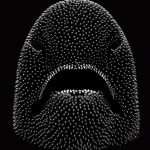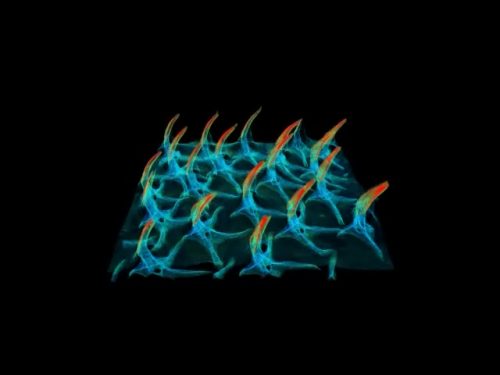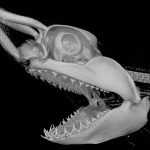The other day I sat down with one of our lab’s collaborators, Dr. Gareth Fraser, to discuss his fascinating research on the evolutionary development of shark teeth and skin.

1. So what are your basic research interests and current projects?
Our lab is interested in a number of questions within the field of EvoDevo – Evolutionary Developmental Biology. We focus primarily on the development and evolution of morphological change in fishes. Several of our projects question the development and regeneration of teeth in fishes, for example, how can sharks produce a lifelong supply of teeth, and why does this process of tooth regeneration never stop? This is an important question because we know very little about the continuous regeneration of any structure. Importantly, humans also have teeth, however, our teeth are limited in the number of replacements we make. We only produce two sets of teeth, milk teeth and permanent teeth that last the vast majority of our lives. Sharks do not rely on two sets of teeth – they have an endless supply of teeth, with a dentition that regenerates constantly throughout life. In some sharks, a new set of teeth develops every two weeks! Our lab studies the factors that control the production of teeth in sharks and other vertebrates, like mammals.
We have therefore been working to investigate the genetic control and the stem cells that govern the continuous production of teeth in sharks and other fishes. We also use other odd fish to understand the evolution and development of morphological novelty, e.g. why does the pufferfish develop a beaked dentition rather than a set of standard teeth, like other fishes? What are the
evolutionary and developmental triggers that produce these new characters? Our work is also focused on the

developmental origins of teeth and whether teeth and tooth-like structures emerged in the skin or mouth of ancient fishes over 400 million years ago. For this reason, we study not only the development of teeth in the mouths of sharks but also the tooth-like scales in the sharkskin (‘skin teeth’) – dentine and enamel-rich structures that can offer us some clues about the relatedness of these structures and the sequence of events that led to teeth in our mouths, perhaps from teeth in the skin that became associated with our mouths as jaws evolved in early vertebrates.
2. What is the goal of this work?
Our work has several research goals that span our interests in developmental, regenerative and evolutionary biology with an aim to find translational links between these fields for important biomedical implications. We are trying to understand, to some extent, the paleo-history of teeth, how and where did teeth emerge during the evolution of vertebrates, and how teeth can be naturally regenerated for future supply in humans, for example. Essentially, we want to learn how nature makes and continues to make structures like teeth, and why these developmental mechanisms may terminate in some animals. If sharks can continuously produce teeth, we want to find out what the factors are that allow this process to continue. We think that stem cells are key to the process of continuous tooth production in sharks and so we want to learn more about the nature of these cells and why humans may have potentially lost the tissues that house these dental stem cells.

3. Why use elasmobranches (sharks and rays)?
Sharks and other elasmobranchs are an incredibly ancient group of cartilaginous fishes with a rich diversity in life history, morphology and ecology. In recent years, sharks and rays have become key models for genomic, developmental and evolutionary biology, and a wealth of information about their biology has been learned. When we think about sharks, in particular, it is hard to not think about the rows and rows of teeth that line the jaws. When I decided to study tooth development and regeneration in fishes, I realized sharks were the ideal model for this research because of the rate of regeneration and the continuous nature of this tooth-forming process. Sharks and elasmobranchs, more generally i.e. rays, are important models for this type of scientific research because they possess a unique set of characters that have a long evolutionary history and by studying these characters, i.e. skin teeth or continuously regenerative teeth, we can obtain data on the origin and evolution of these important traits.
Egg-laying (oviparous) elasmobranchs are excellent research species that can be grown under controlled conditions in the laboratory, where development can be traced and studied in great detail. We can breed sharks or just collect eggs (sometimes called Mermaid’s purses) from non-vulnerable species (e.g. the small-spotted catshark – Scyliorhinus canicula) and transfer them to the lab for further study. This species generally takes between 9 and 12 months to develop in the egg-case, before the young shark hatches and looks a lot like a mini version of its parents.
4. Why should people outside of science care about what you do?

We use sharks (and other fishes) for basic scientific research, to identify mechanisms of development that can inform how we can generate new advances that will benefit human life. The transferable nature of this work can be important to the fields of both medicine and engineering. Therefore, to fully appreciate the development and function of genes essential to the process of tooth development it is crucial to understand the evolutionary history of these developmental units and the progression of development. This can allow us to use the genetic information gleaned from the continuously regenerative teeth to ask (i) why other animals like humans have lost this ability to remake extra generations of teeth and (ii) is it possible to naturally make new teeth for humans that have lost permanent teeth? So, sharks may have an important role in teaching us about the evolutionary history and genetic and cellular recipe for making new and natural teeth.
Also, the fact that all sharks have tooth-like structures embedded in their skin (called dermal denticles) allows us to learn about the function of these ancient skin teeth. Several labs around the world study shark denticles not only because these skin teeth provide protection to the shark, but they also offer the shark advantages during swimming performance, and they are able to reduce the attachment of parasites and other unwanted hangers-on. These tooth-like scales allow the shark to swim with a marked reduction of drag in water – meaning the shark can swim more efficiently and faster because of these skin denticles. These structures are popular with engineers and scientists that look to nature for new design ideas (biomimetics) and then may attempt to design new energy-efficient products and vehicles, covered with shark denticle-like elements to reduce drag, save energy and even reduce CO2 in the atmosphere. Even speedo has designed ‘fast-skin’ swimsuits that utilize sharkskin technology to help make people swim faster!
Much of the shark research we perform at the University of Florida has great relevance to the development of new technologies that will ultimately benefit our lives in the future.
Check out Dr. Fraser’s lab website and follow his research on Twitter!
